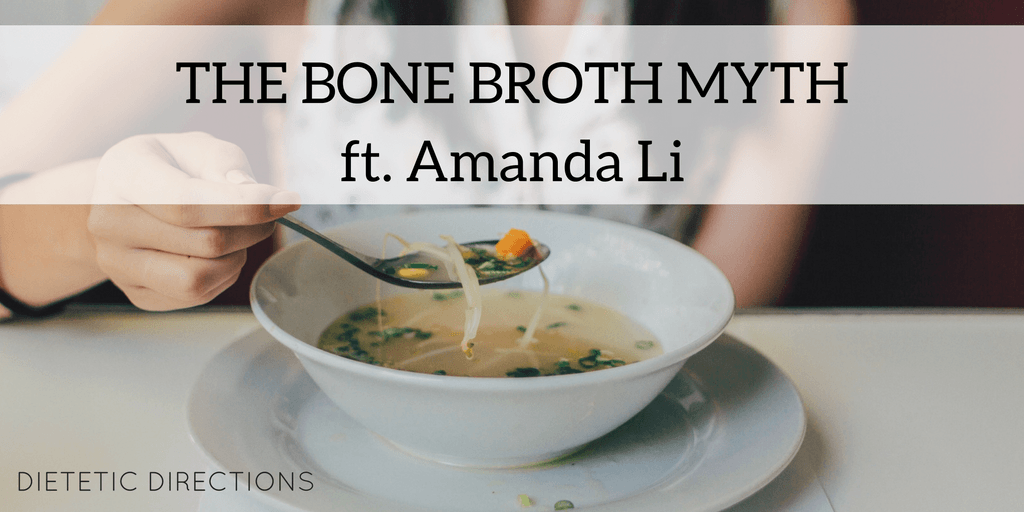
The Bone Broth Myth
I’d like to give a big welcome for my first out-of-province guest blogger, Vincci Tsui! Vincci is based in Calgary and I was drawn to her after seeing several of her media appearances on Breakfast Television. I admire Vincci for her simplicity in breaking down the science and de-bunking many nutrition myths! Today she will be de-bunking the bone broth myth.
I’ve learned that bone broth is slowly (but steadily) becoming a thing. Fuelled equal parts by the Paleo movement and Kobe Bryant, bone broth is becoming so popular that Brodo, a takeout window that doles out hot cups of broth, recently opened in New York!
What makes bone broth different from say, regular broth or stock?
The difference between bone broth, regular broth and stock is not just semantics. According to Nourished Kitchen, bone broth is made with minimal meat, and simmered for much longer than stocks or broths – up to 1-2 days. The goal is to simmer it for so long that the “minerals have leached from the bones” and the bones themselves become brittle. Often vinegar is added to bone broths so that the acid can help leach the minerals from the bones.
Is bone broth rich in calcium and minerals?
Although broth is a food as old as time, the idea of it being a superfood is relatively new, so there are few studies of its contents. Even the Canadian Nutrient File only has nutrient analyses of commercial broths. I only boldly made a statement on a Twitter chat because I remember in my early days as a dietitian, I used to give out this handout which says that the amount of calcium in “boiled bone soup” is “negligible”.
In this recent blog post by Kaayla T. Daniel, the co-author of a new book called Nourishing Broth: An Old-Fashioned Remedy for the Modern World, she states that she had to go as far back as 1934 to find a thorough review of the calcium content of bone broth, and the results were abysmal – about 12.3-67.7 mg per cup. In other words, you would have to drink 5-26 cups of broth to equal the same amount of calcium in a cup of milk (322 mg calcium per cup)! Interestingly, Daniel notes that the study found that the broths with the highest calcium also included vegetables. Daniel and lead author Sally Fallon Morell ran their own experiments, and found even worse results – a chicken bone broth had only 2.3 mg of calcium per cup, and a bone broth made with vegetables contained 6.1 mg per cup.
DYK: you would have to drink 5-26 cups of broth to equal the same amount of calcium in a cup of milk? Share on XWhat about the other minerals? Lawrence Dubois, manager of Salt Spring Natureworks and reader of Alive, a natural health magazine, recently did his own analysis by preparing several varieties of bone broths (plus a nettle and dandelion broth) and sending them off to a lab for analysis. He found that his bone broths contained about 1.6-21.6 mg per cup. Other minerals that bone broth is purportedly high in, like magnesium, phosphorus and potassium, clocked in quite low as well, as illustrated by this table I made below:
| Nutrient | Amount in Bone Broth (per cup) | Daily Recommended Intake (DRI) for Adults | Example of an Excellent Source |
| Magnesium | 1.4-4.8 mg | 300-420 mg | Pumpkin seeds (207 mg per ¼ cup) |
| Phosphorus | 0-17 mg | 700 mg | Milk (245 mg per cup) |
| Potassium | 0-167 mg | 4,700 mg | Baked potato with skin (926 mg) |
OK, what about collagen?
One thing that Dubois did find was that the bone broths all contained a good amount of protein – about 12-30 grams per cup. It’s assumed that most of this protein comes in the form of collagen. Collagen is the most abundant form of protein in our bodies; it is the main component of connective tissue and makes up about 25-35% of our total protein mass. The terms collagen and gelatin are sometimes used interchangeably – gelatin is a hydrolyzed form of collagen, meaning that the original bonds between the components in the collagen molecule are broken down and reformed into a slightly different structure. Otherwise, their chemical structure is similar, and commercial gelatin is generally made from the same stuff that people would make bone broth out of.
So, is this why they serve so much Jello at old folks’ homes and hospitals? It’s not as simple as more dietary collagen = more body collagen (just like less dietary cholesterol does not always equal lower blood cholesterol). Our stomach acid deactivates all proteins and our bodies break them down to their individual amino acids. As a protein, collagen/gelatin is not considered a good source, as it does not contain all of the essential amino acids (i.e. the amino acids that we can only get from diet). The two amino acids collagen is known for, proline and glycine, are both non-essential amino acids that our bodies can make as long as it is getting adequate, complete protein. Most other animal sources, like whey (dairy) and eggs, are considered complete proteins as they contain all of the essential amino acids. Some plant sources, like soy, are also complete proteins.
Bottom Line
This is not a hate on to food cultures where broth has played a huge role – most Chinese soups are broth-based, and I remember growing up we had to have a bowl before and after our dinner meal. There is even an oft-quoted South American proverb that “Good broth will resurrect the dead.” Still, based on the weak evidence behind its current claims, I’m not convinced that bone broth deserves all this superfood buzz.



